The Skyscraper Museum is devoted to the study of high-rise building, past, present, and future. The Museum explores tall buildings as objects of design, products of technology, sites of construction, investments in real estate, and places of work and residence. This site will look better in a browser that supports web standards, but it is accessible to any browser or Internet device.
SKYSCRAPERS OF 100+ STORIES
IN CHRONOLOGICAL ORDER
VIEW THE SLIDESHOW
Our first TOP TEN graphic lined up buildings of 100+ stories that in April 2015 were completed or were “topped out” –meaning they had achieved their full vertical height.
History is the approach of this list, which organizes chronologically all the buildings in the world that are, or were, 100 or more stories – from the first, the Empire State in 1931, through all towers that were topped out in April 2015. There are 17 in our frieze of silhouettes, including the twin towers of the original World Trade Center, destroyed on 9/11. Today, there are 15 buildings worldwide that are 100 stories or taller.
Scroll right to see view the entire lineup. View the entire list with heights.
The first five are 20th-century skyscrapers — all office buildings, constructed of steel, and located in New York or Chicago. Since 2000, all new 100+ story buildings have been erected in China or the Middle East, save for One WTC.
What can we learn from this line-up? First, that the rise of the skyscraper is not a continuous climb from small to tall focused on record-breaking height. Since the Burj Khalifa opened in 2010, there have been nine new 100+ story towers. Another nine are now in some stage of construction, but the only one that will surpass the Burj Khalifa is the Kingdom Tower in Jeddah, Saudi Arabia.
While the impulse to erect a record-breaking tower is a perennial attraction and can prompt an architectural feature or ornamental finial to stretch its vertical height, our line-up shows the great majority of 100+ story towers have flattish tops. Only the Empire State, Taipei 101, Burj Khalifa, One WTC, and, arguably, Makkah Clock Tower, rely on a slender spire to add altitude with unoccupied floors.
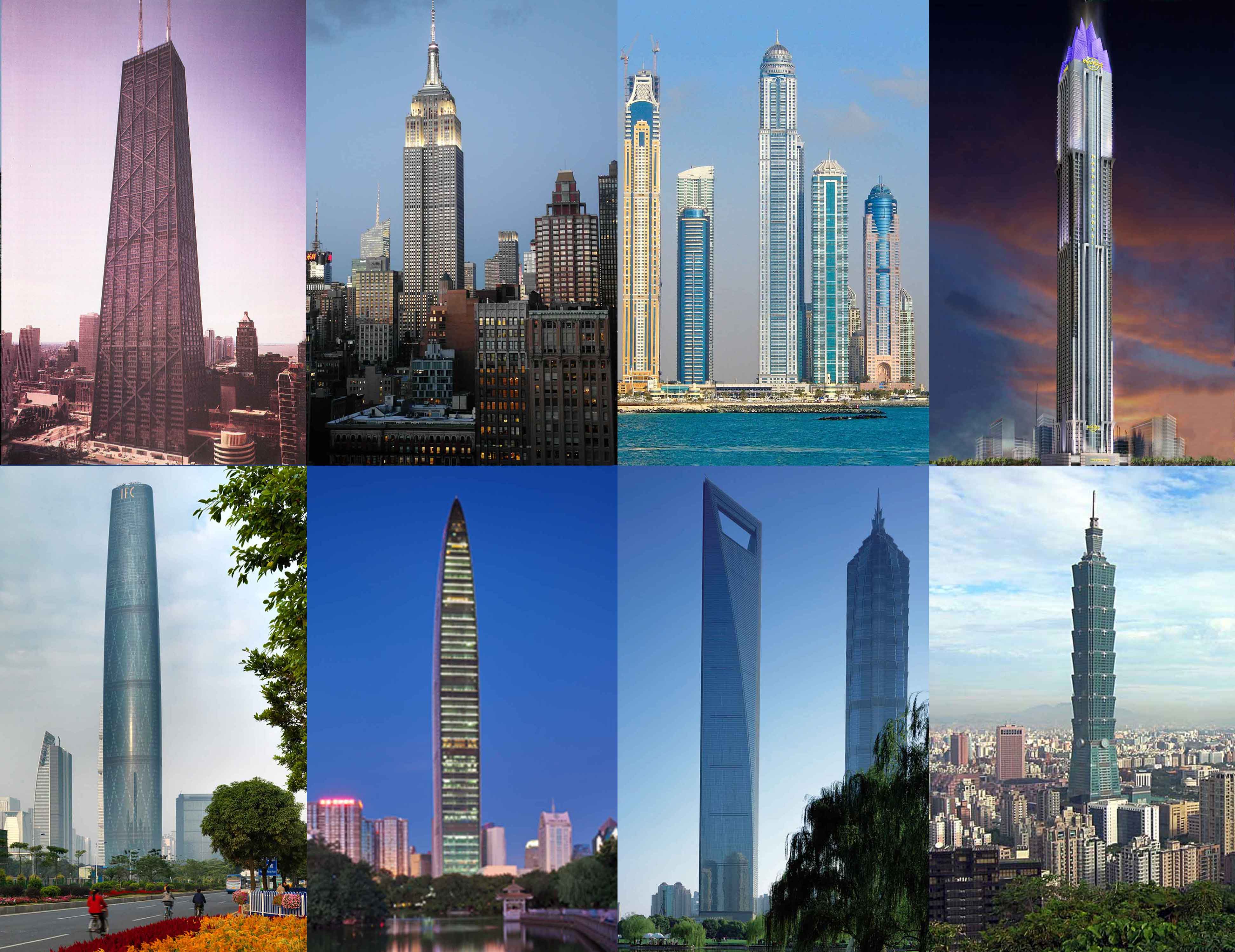
Of the 15 buildings in our category of topped-out towers of 100+ stories, more than half cluster in a group of 100 to 103 stories. Those 8, pictured above, display a wide variation in vertical height. The shortest is Chicago’s John Hancock Center at 344 m/ 1,127 feet. KK 100 in Shenzhen, China, is almost 100 meters taller at 442 m/ 1,449 feet. The tallest 101-story tower is Taipei 101 at 508 m/ 1,667 ft., when one counts the slender spire, exceeding the Shanghai World Financial Center’s 492 m/ 1,614 feet.
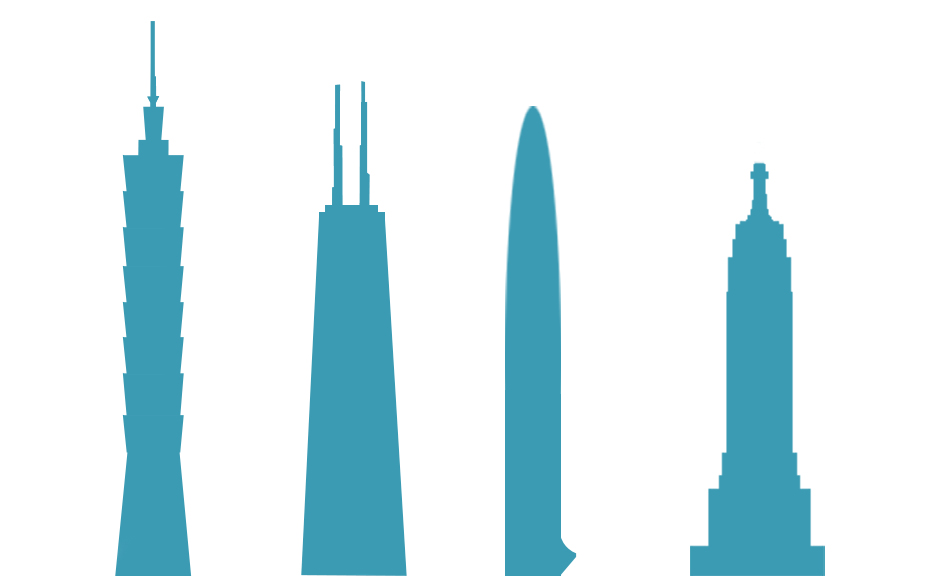
L to R: Taipei 101, John Hancock Center, KK 100, and the Empire State Building. This lineup illustrates the difference in heights of four buildings with floor counts of 101, 100, 100, and 102 stories, respectively. Scaled silhouettes courtesy of CTBUH.
The 300- to 500-foot difference in height illustrated in the graphic above– with little difference in floor count – can be explained in two ways: one objective, the other slippery. Put simply, the John Hancock Center is short because its true 100 stories have short slab-to-slab ceiling heights, especially for its upper residential floors.
What counts as a story, though, can be very subjective, or culturally determined. Residential towers often exaggerate numbers to make their penthouses seem higher. Many developers leave out some “unlucky” floor numbers, like 13 in the United States, or floors with “4s” in China, where the character can be associated with death. Throughout Asia, the character for the number 8 has an association with luck, so 88 is a favored height in the official number of stories. The number 100 or 101 seems to have appeal as a significant number and is sometimes used in the name, as is KK100.
While ranking buildings by their number of stories is so imprecise as to be almost pointless, the category of towers of 100 stories or taller yields an impressive line-up, as our scaled graphic ordered by date shows. This graphic, we think, is a more convincing group of truly big buildings than the CTBUH ranking by architectural height illustrated below.
. Scroll right to see view the entire lineup.

VIEW THE SLIDESHOW
1. EMPIRE STATE BUILDING
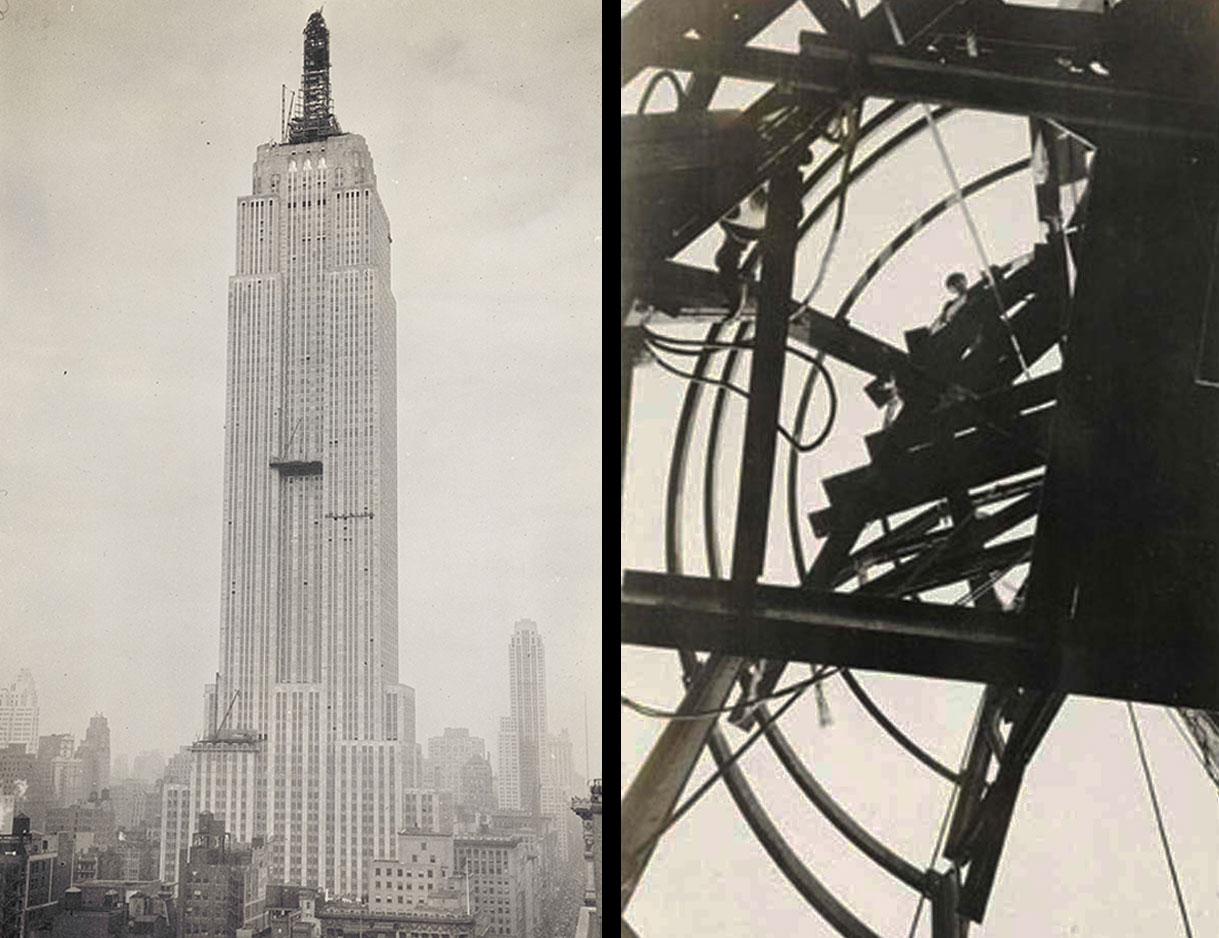
Erection view of Empire State Building, 11/1930.
Collection of The Skyscraper Museum VIVA2 Virtual Archive.
New York, USA 102 fl 381 m / 1,250 ft (completed 1931)
Completed in 1931, the Empire State was the world’s first 100-story building – or rather, the equivalent of 102 stories, since the floors between the 86th floor observation deck and the small room at the apex of the mooring mast were only estimated levels.
The silver spire that gives the skyscraper its iconic silhouette and twenty percent additional height was a later addition to the design of the 1,050-foot, flat-topped office building. The height evolved from 80 stories in early stages, to 85 floors, topped with an observation deck that was designed to be a major tourist attraction and revenue stream.
The addition of the 200-foot “mooring mast” – which brought the total height to 1,250 feet – was clearly intended to decisively claim the title of world’s tallest building. The Chrysler Building had topped out in October 1929 at 1,046 feet, surpassing 40 Wall Street at 927 feet. In December, newspapers reported that the Empire State would be topped with a stainless-steel spire that would serve as a landing station for dirigibles for long-distance business travelers.
The Empire State Building ruled as the world’s tallest building for forty years, until the completion of the North Tower of the World Trade Center in 1971.
See Empire State Building in TEN TOPSView construction photographs of the Empire State Building VISUAL INDEX TO THE VIRTUAL ARCHIVE 2.
2. JOHN HANCOCK CENTER

Chicago, USA 100 fl 344 m / 1,128 ft (completed 1969)
The collaboration of the partners in the Chicago office of Skidmore Owings & Merrill, architect Bruce Graham and structural engineer Fazlur Khan, created two influential skyscrapers of 100 and 110 stories that still define the city’s skyline: the John Hancock Center, which topped out in May 1968, and the Sears (now Willis) Tower.
The John Hancock Center was in many ways a prophetic project. The tapered tower presented a strongly expressive structural system in which diagonal braces acted as an enormous truss to tie together the steel columns. It was also a mixed-use building that combined the programs of office space on floors 13 to 41 and apartments from floors 45 to 92. On the 95th and 96th levels was a double-story height restaurant. The views of Lake Michigan and the street grid of the Illinois prairie from these heights, as well as from the observation deck on the 94th floor, have changed considerably since the 1970s, but the classic modernism of the John Hancock Center has not diminished.
See John Hancock Center in TEN TOPS
3. WORLD TRADE CENTER (North Tower)

Right: Iron Workers from New York Local 40 and PANYNJ moving a section of the World Trade Center antenna into place. Photographed 1,650 feet above the streets of New York and 350 feet above the North Tower of the World Trade Center. Image copyright: Peter B. Kaplan 1979. Courtesy Peter B. Kaplan
New York, USA 110 fl 417 m 1,368 ft (completed 1971)
The original World Trade Center epitomized the ambitions of an era when faith in technology and a fascination with monumentality spurred designs for megastructures and urban master plans. On their completion in 1971 and 1973, the Twin Towers were both the tallest and the largest skyscrapers in the world. Innovative engineering carried the structures to 110 stories. At 1362 and 1368 feet, and with floor plates of nearly an acre, the space of each tower was more than 4 million sq. ft.
In 1962, after a series of design studies developed with a team of prominent New York architects, the Port Authority of New York and New Jersey awarded the commission to design the World Trade Center to Minoru Yamasaki. The program called for 10 million square feet of office space built over a mass transit station. There was no prescribed number, height, or configuration of the buildings. Yamasaki and his associates built a context model of the site and began to experiment with different massing studies. Although they ultimately tested over a hundred schemes, on the seventeenth variation Yamasaki fixed on the idea of two square-footprint towers of about 80 stories, set askew in a five-acre plaza framed by low-rise buildings. The Port Authority later increased the height to 100 stories, then to 110 in order to make the towers definitively the world’s tallest, following a suggestion said to have originated with the Port Authority's public relations staff.
* Destroyed on 9/11View the Skyscraper Museum WTC Dossier.
4. WORLD TRADE CENTER (South Tower)

Right: credit Peter B. Kaplan, 1979.
New York, USA 110 fl 415 m 1,362 ft (completed 1973)
The North Tower was ready for its first tenants in late 1970, though the upper stories were not completed until 1972; The South Tower was finished in 1973. The vast dimensions of the World Trade Center created a veritable vertical city. Each tower measured 209 ft. on each side, comprising more than 40,000 sq. ft. of floor space, minus the core area of elevator shafts, circulation, and mechanical systems. The “tube” construction with its exterior bearing wall and 40- to 60-foot long floor trusses provided column-free space in the offices. This “open plan” was a favored feature of postwar office buildings and contrasted dramatically with the typical space in earlier twentieth-century skyscrapers such as the Empire State, where a 3-D grid of the steel skeleton structure placed columns every 18 to 22 feet.
In 1967, the PANYNJ planned to erect a television antenna on the roof of the North Tower. Yamasaki vehemently opposed the mast, arguing that it would destroy the symmetry of the towers and "throw the silhouette of downtown Manhattan out of balance." His entreaties were not successful, but various disputes and lawsuits held up the project for ten years. In 1977, a deal was reached to erect the antenna. In 1979, photographer Peter B. Kaplan documented the construction of the 360-foot mast, spending twelve days aloft with the ironworkers installing the antenna. Broadcasts began in June, 1980.
* Destroyed on 9/11
View construction photographs of the World Trade Center VISUAL INDEX TO THE VIRTUAL ARCHIVE 2.
5. SEARS/ WILLIS TOWER
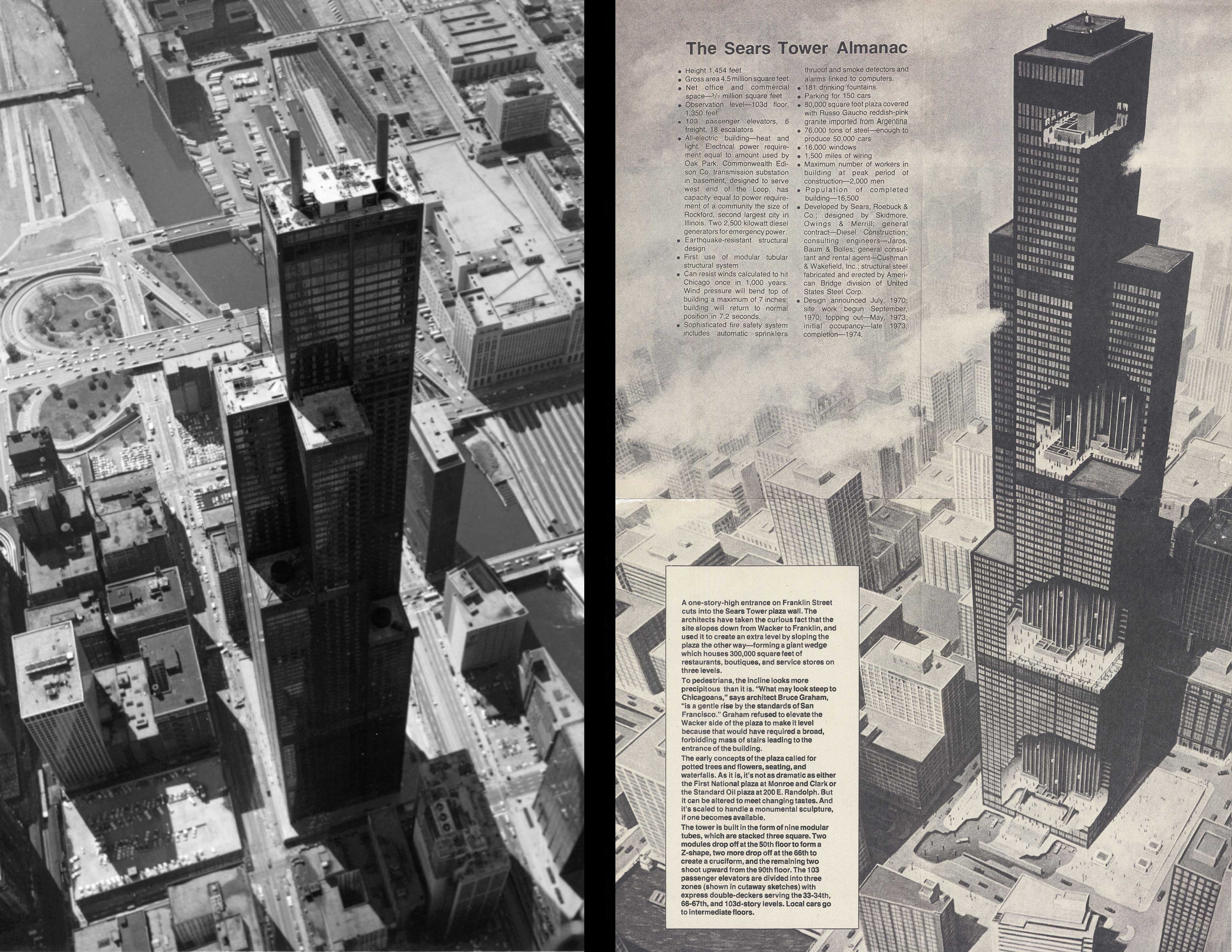
Chicago, USA 110 fl 442 m / 1,451 ft (completed 1974)
In July 1970, Sears Roebuck and Company, then the world's largest retailer, announced plans to build the world's tallest building in downtown Chicago. Part headquarters and workspace for 13,000 employees, part rentable office floors, at 1,451 ft., the Sears (now Willis) Tower exceeded the North Tower of the World Trade Center by 82 feet and held the record of world;s tallest building for more than 20 years, until surpassed by the slender spires of the 88-story Petronas Towers in Kuala Lumpur in 1998.
The innovative and efficient steel structure was a "bundled tube" system of nine squares with sides of 75 feet (for an overall 225 x 225 ft.), sheathed in a curtain wall of dark tinted glass. Above the fiftieth floor, some squares dropped away as the tower rose to create smaller floor plates and a distinctive stepped silhouette.
The Skydeck Pavilion on the 103rd floor was added in 1985 by Skidmore Owings and Merrill as a tourist observation deck. In 2009, the attraction was renovated to incorporate retractable glass-floored balconies that extend four feet from the tower.
Visit the SUPERTALL virtual exhibit6. TAIPEI 101

Taipei, Taiwan 101 fl 508 m / 1,667 ft (completed 2004)
Taipei 101 was the first 100+ story skyscraper built in the 21st century and reigned for seven years as the world’s tallest building by virtue of the 60-meter spire that stretched its height to 1,667 feet. The form, reminiscent of a traditional pagoda, repeats the number eight—which is associated with prosperity and good fortune—in eight stacked eight-floor units.
The tower’s top section is a major tourist attraction that offers multiple observation levels with unparalleled views of the city. At level 91, visitors may go outside, but on levels 88 and 89 the view is also inward, to the display of the golden sphere of a tuned mass damper (TDM), an engineering mechanism designed to stabilize building sway. The 660-ton sphere has an 18-foot diameter and hangs from eight cables secured at the 92nd floor. The TMD can reduce resonance by 40 percent and under normal conditions can move up to 13.8 inches. During major typhoons, the TMD can move up to 59 inches, as the video here shows.
See Taipei 101 in TEN TOPS7. SHANGHAI WORLD FINANCIAL CENTER

Shanghai, China 101 fl 492 m / 1,614 ft (completed 2008)
It took 15 years for the Shanghai WFC to go from first plans to opening, in part due to a four-year pause in construction caused by the late ‘90’s Asian financial crisis. When construction resumed in 2001, the tower’s design gained nearly 105 feet and the central design element of the tower’s top – a large circular opening – had changed to a square prism. Originally intended by the architect to evoke ancient Chinese celestial stone disks that represent the heavens, as well as the moon gates of traditional Chinese gardens, Chinese government officials instead saw the rising sun of the Japanese flag. The square prism represents the updated, compromise design and holds the indoor observation levels that occupy the floors that define the top and bottom of the trapezoid.
See Shanghai World Financial Center in TEN TOPS8. BURJ KHALIFA
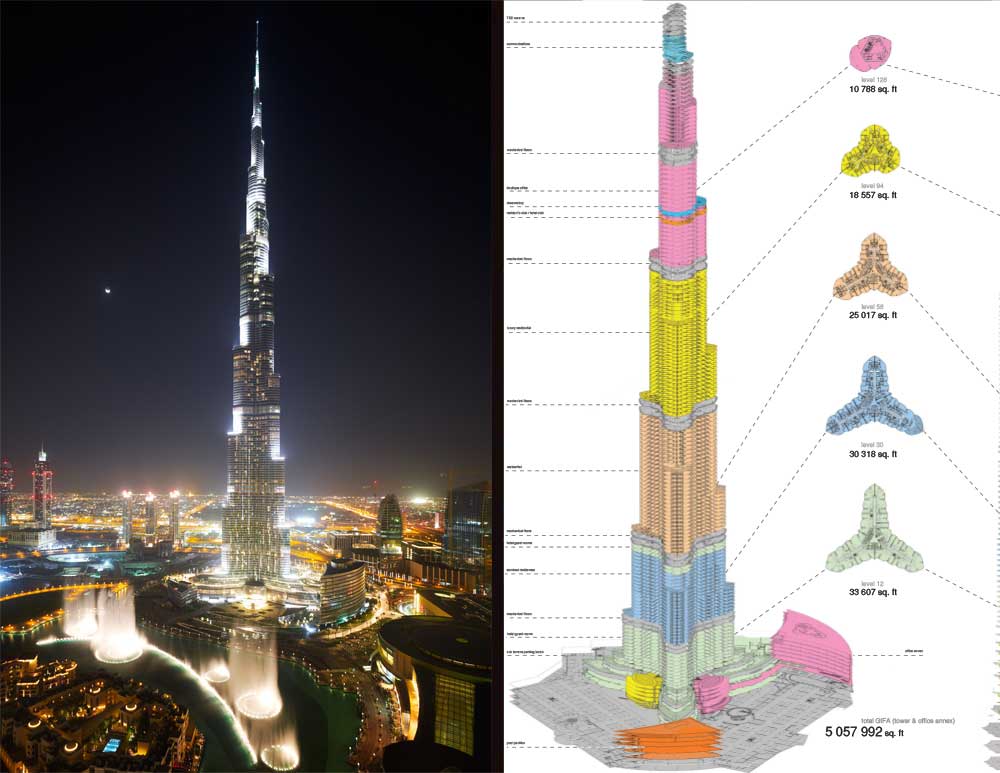
Dubai, UAE 163 fl 828 m / 2,717 ft (completed 2010)
At 828 meters/ 2,717 feet, Burj Khalifa is the tallest building in the world in all three categories of the Council on Tall Buildings and Urban Habitat. Taller than two Empire State Buildings, it surpasses the current second-tallest structure, Shanghai Tower, by nearly 700 feet.
Principally residential, the 163-story Burj Khalifa is a mixed-use building that reverses the normal planning logic: the lower stories are occupied by a boutique hotel, above which there are condominium apartments up to the level of the first observation deck on the 124th floor. The top 37 floors, those with the smallest floor plates, are reserved for elite corporate office suites, save for a second observation deck on the 148th floor.
Above level 156, the concrete structure tower switches to steel. The final 136 meters of the spire, a steel pipe weighing 350 tons, had to be assembled in sections within the tower, then jacked into place.
See Burj Khalifa in TEN TOPS
9. INTERNATIONAL COMMERCE CENTER

Hong Kong 118 fl 484 m / 1,588 ft (completed 2010)
The tallest building in Hong Kong, the International Commerce Centre (ICC), together with its visual counterpoint, the IFC2 across the water on Hong Kong Island, marks the entrance to Victoria Harbor. The building's 118 stories house over 2.5 million square feet of offices and are crowned by a Ritz-Carlton Hotel, which is the highest hotel in the world. While it has never reigned as the world's tallest building, the ICC does feature the world’s highest cocktail lounge and the world’s highest swimming pool, both located at 1,538 feet, on the 108th floor.
See ICC in SUPERTALL!10. GUANGZHOU IFC
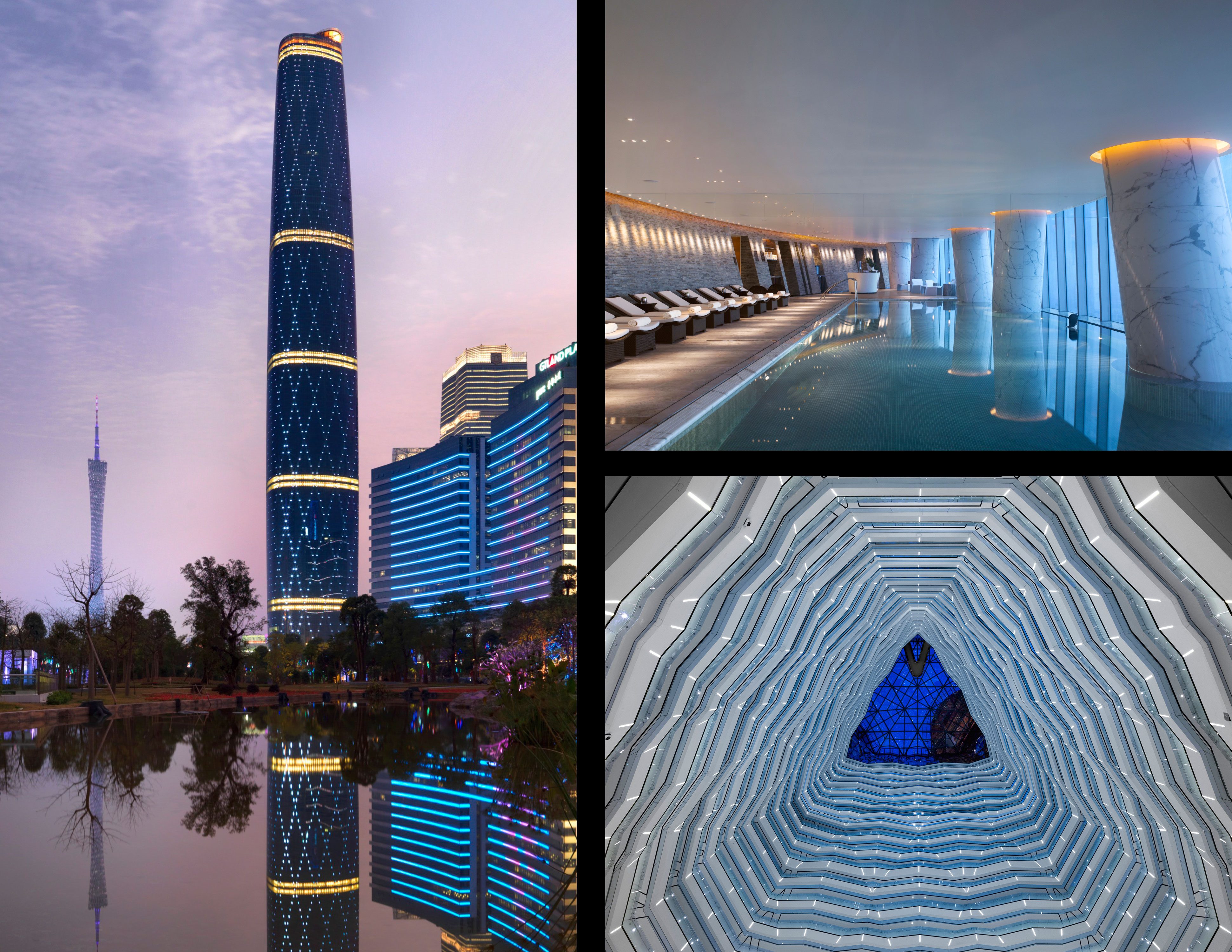
Guangzhou, China 103 fl 439 m / 1,439 ft (completed 2010)
This 440-meter tower rises from a triangular footprint with rounded corners, giving the form an overall curved façade. The lower 66 floors contain office space, and a luxury hotel with a full-height atrium, seen in the model photographed below, stretches another 30 floors above before reaching two observation levels at the summit. Rising out above the uppermost floor is a helicopter-landing pad. The building's most distinctive feature is its perimeter diagrid structural system, which allows for column-free floor plates and drastically reduces the tonnage of steel required for construction.
See IFC in TEN TOPS11. KK100

Shenzhen, China 100 fl 442 m / 1,449 ft (completed 2011)
KK100’s curved form and parabolic arch top is meant to evoke the image of a fountain, a symbol of wealth and prosperity. At 100 stories, the mixed-use tower combines an office building below and hotel in the top 26 floors, organized in a ring around a dramatic open atrium. Guests of the St. Regis Shenzhen take elevators directly to the 94th floor Sky Garden Lobby, which opens up into a 6-story cathedral-like space that holds the hotel’s multi-level dining venues and offers breathtaking views of Shenzhen and Hong Kong's New Territories to the south.
See KK100 in TEN TOPS12. MAKKAH ROYAL CLOCK TOWER
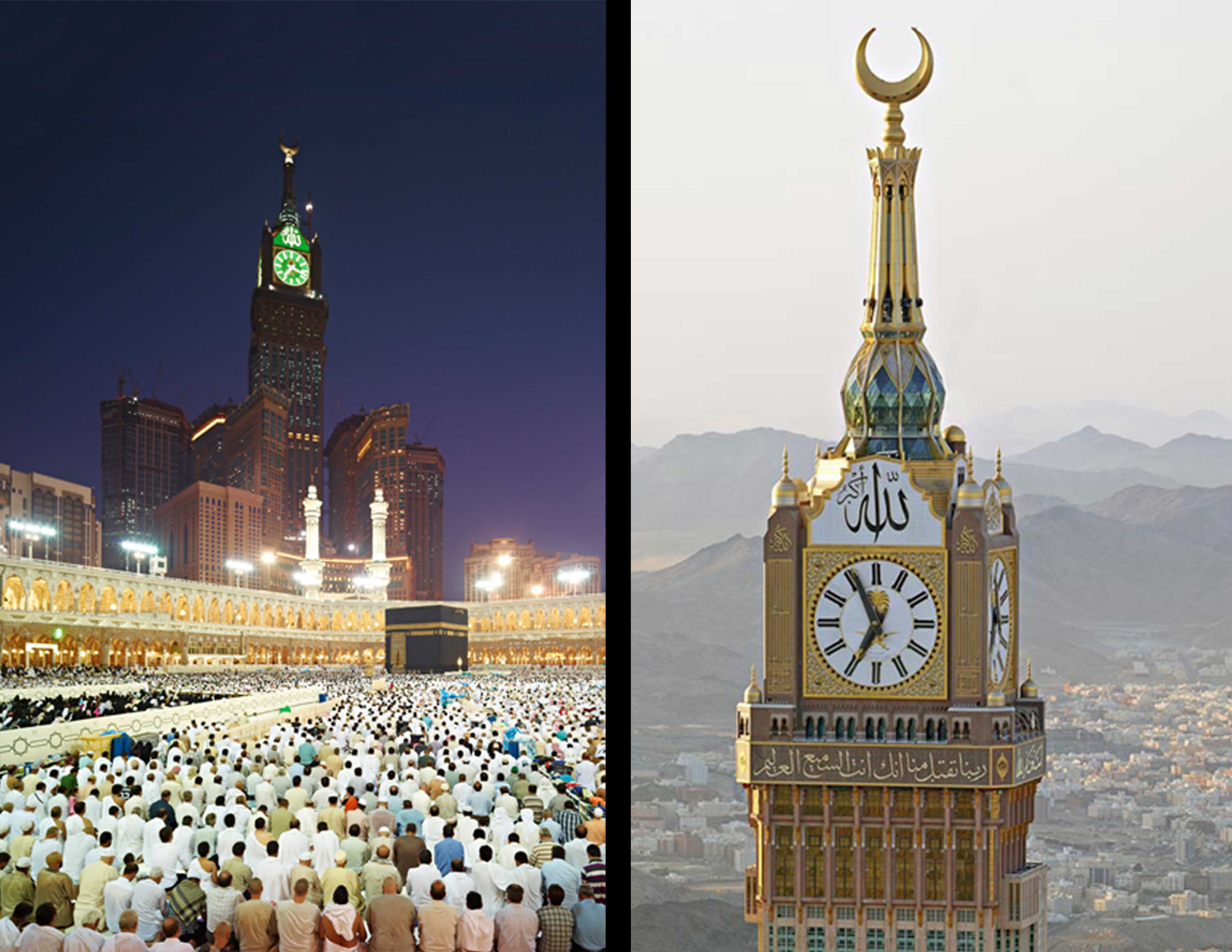
Mecca, KSA 120 fl 601 m / 1,972 ft (completed 2012)
Little known outside of the Muslim world, the Makkah Royal Clock Tower was a separate commission from the high-rise hotel below. The engineers at the German firm SL Rasch were asked to create the world’s largest clock atop the building already under construction. Their work began 347 meters above ground on a structure of steel weighing 12,000 tons. In addition to the clock’s precision mechanisms, inside the spire are also an astrological observatory, exhibition space, observation deck, and the Makkah Time Institute. The golden crescent, known as the Hilal, is the symbol of the Prophet and the acme of the Clock Tower. It contains the world's highest prayer room at 592 meters for the royal family and dignitaries.
See Makkah Royal Clock Tower in TEN TOPS13. PRINCESS TOWER

Dubai, UAE 101 fl 414 m / 1,358 ft (completed 2012)
The Princess Tower, a residential tower is the world’s fifteenth tallest building, and is the second tallest building in Dubai. The building took six years to construct and when it was completed in 2012 it was the world’s tallest residential building. The tower has 101 stories and contains 763 apartments, 957 parking bays on 6 levels, and 8 retail outlets. In order to make the most profit, the Dubai Marina development is to pack many apartments per floor. The building also has both indoor and outdoor pools, and a gymnasium for residents. The top apartment, a luxury penthouse occupies the 98th floor with the next three floors to the dome being a playing floor and three service floors. The highest occupied level (a service floor) is 358 meters / 1,175 feet leaving another 34 meters / 111 ft to the top of the dome which reaches 392 meters / 1,286 feet.
See Princess Tower in TEN TOPS14. ONE WORLD TRADE CENTER
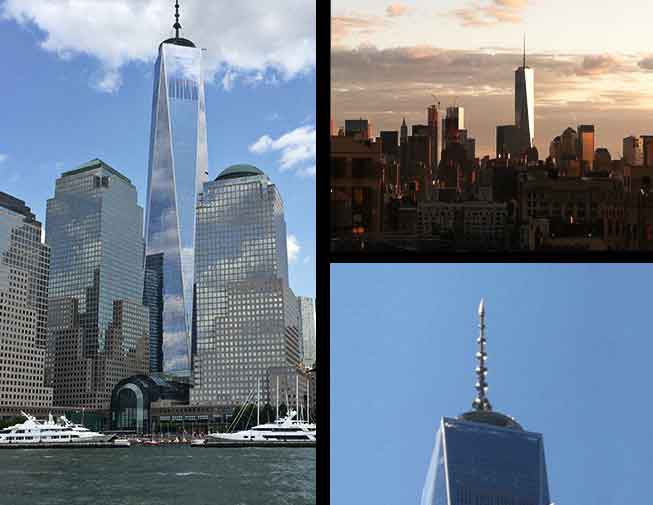
New York, USA 104 fl 541 m 1,776 ft (completed 2014)
The tallest building in North America almost wasn’t the tallest. One World Trade Center’s spire was originally designed with a shell of interlocking fiberglass triangles fashioned into a tapered form known as a radome. This spire was redesigned and simplified, which called into question if the new structure qualified as an integral architectural feature, a definition that distinguishes add-on antennas from architecture, according to one definition of vertical height by the referee organization the Council on Tall Buildings and Urban Habitat. What was at stake was the title of “Tallest Building in North America,” which after 9/11 belonged to Chicago’s Sears/Willis with its architectural height of 442 m / 1,451 ft. At a dual news conference in New York and Chicago, attended by international media on November 12, 2013, the CTBUH announced the ruling of its Height Committee that the spire of One WTC should be treated as an architectural feature, and thus One World Trade Center officially became the tallest building in North America.
See One World Trade in TEN TOPS15. SHANGHAI TOWER
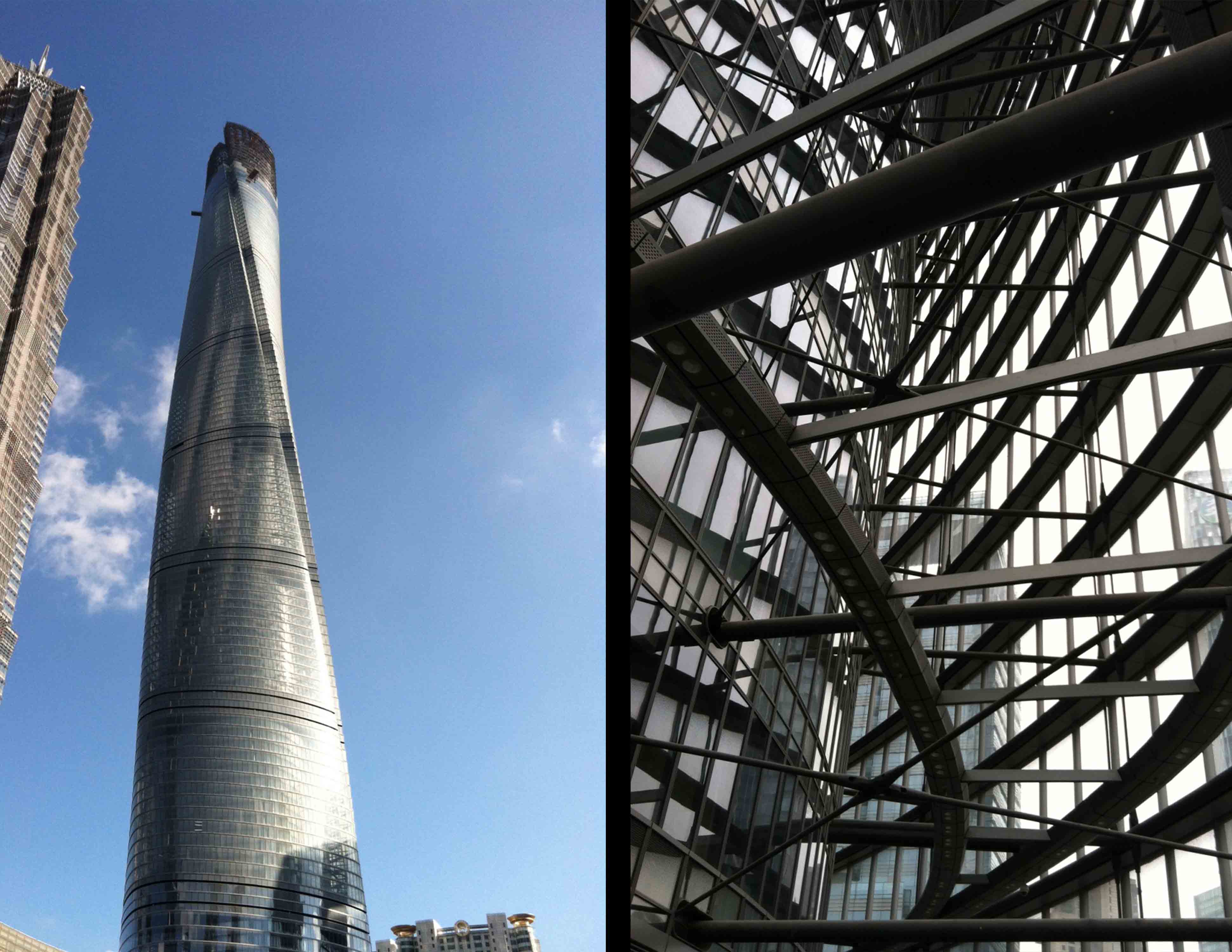
Shanghai, China 128 fl 632 m / 2,073 ft (completed 2015)
Shanghai Tower topped out in October 2014 and is scheduled to open late this year. Organized in nine sections which function essentially as separate buildings stacked vertically, the tower’s usable floor space is contained within symmetrical cylinder with its own glass curtain wall. Around this internal structure rises another facade of glass that is triangular in shape and rotates as it rises. This double-skin affords an insulating effect to control air temperature and quality. It also creates a series of 14-story high atrium public spaces or “sky gardens” intended to create a sense of community for the occupants and visitors in that zone of the tower.
The top segment of Shanghai Tower is devoted to a luxury hotel, The Four Seasons, public observation decks, and an open “crown” that adds seven more levels above the 121 occupied floors. The open roof, surrounded by a partially-glazed grill of steel, encloses a host of environmental and engineering features such as cooling towers, a tuned mass damper, tracks for window-washing equipment and 270 Horizontally-oriented wind turbines that can produce more than 150,000 kWh annually and can power the exterior lighting and public spaces.
See Shanghai Tower in TEN TOPS16. MARINA 101
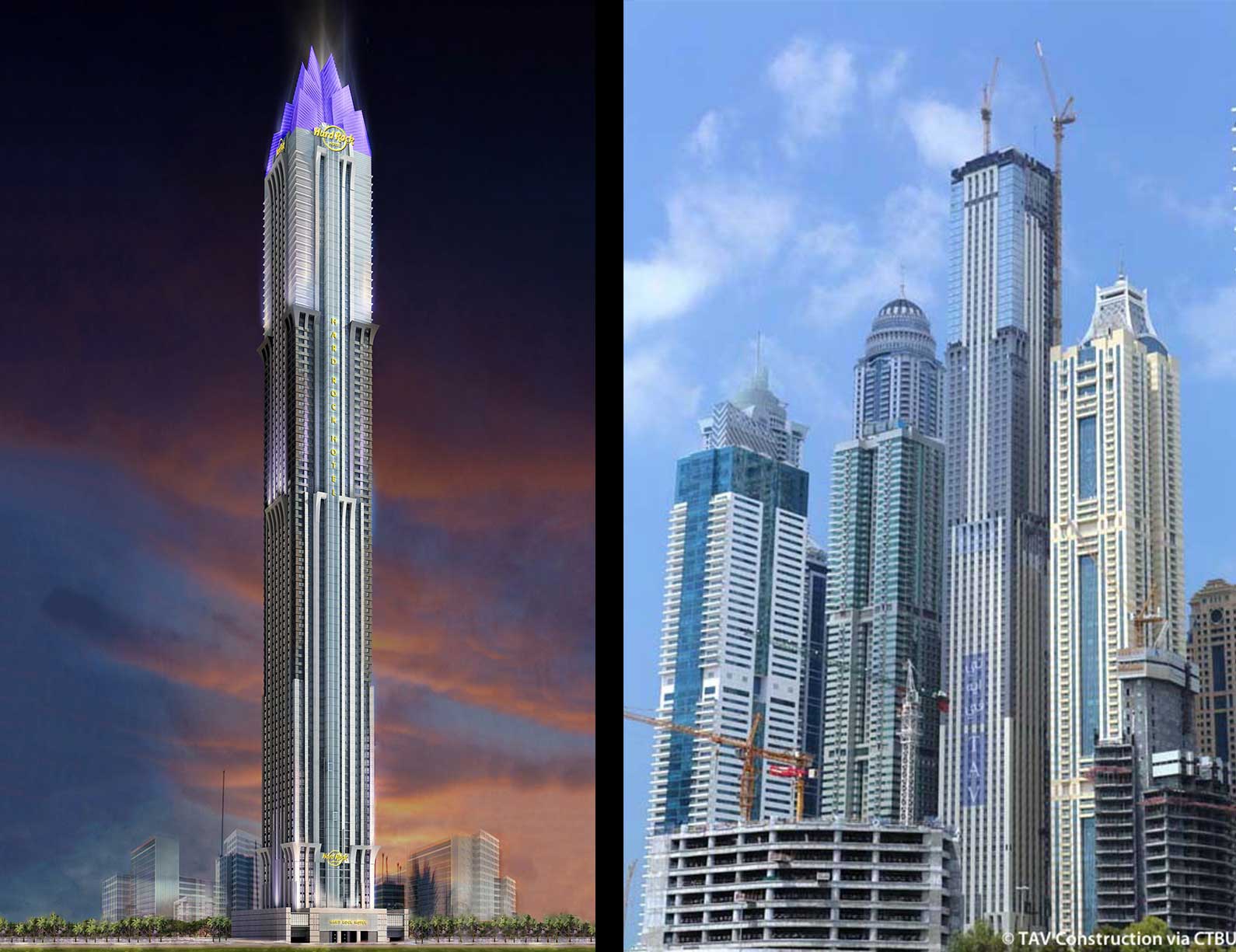
Image right: ©TAV Construction via CTBUH.
Dubai, UAE 101 fl 439 m / 1,439 ft (topped out 2015)
In order to achieve their 100+ -story height, developers and their architects have employed a strategy of slenderness, often creating pencil-thin towers.
Developers in the United Arab Emirates often cluster their buildings very close together, not for lack of space, but to create an instant urban concentration around an attraction or amenity. This allows easy pedestrian access to all facilities in an environment that is dictated heavily by the automobile.
In the collection of seaside towers in the Dubai Marina development, the strategy for profit is to pack many apartments per floor. Marina 101 is a mixed-use tower with a Hard Rock Hotel in the lower 33 floors and apartments above. The 101st floor will feature a Hard Rock Café & Lounge with a 360-degree view of the city.
See Marina 101 in TEN TOPS17. CTF FINANCE CENTER

Image right: Courtesy KPF.
Guangzhou, China 111 fl 530 m / 1,739 ft (topped-out 2015)
Topped out in mid-2014, the CTF Finance Centre is currently China’s second tallest tower. Designed by Kohn Pedersen Fox, the skyscraper's form changes as it rises, reflecting its functions of offices, apartments, and hotel. The shaft sets back at four angled parapets, to create sky terraces and skylights that illuminate the interior spaces below. The facade is clad in white terra cotta and metal for a shimmering effect of lightness and reflections.
View CTF and other Chinese Skyscrapers in TEN TOPS TEN TALLEST 100+ STORY SKYSCRAPERS
View TEN TOPS virtual exhibition

